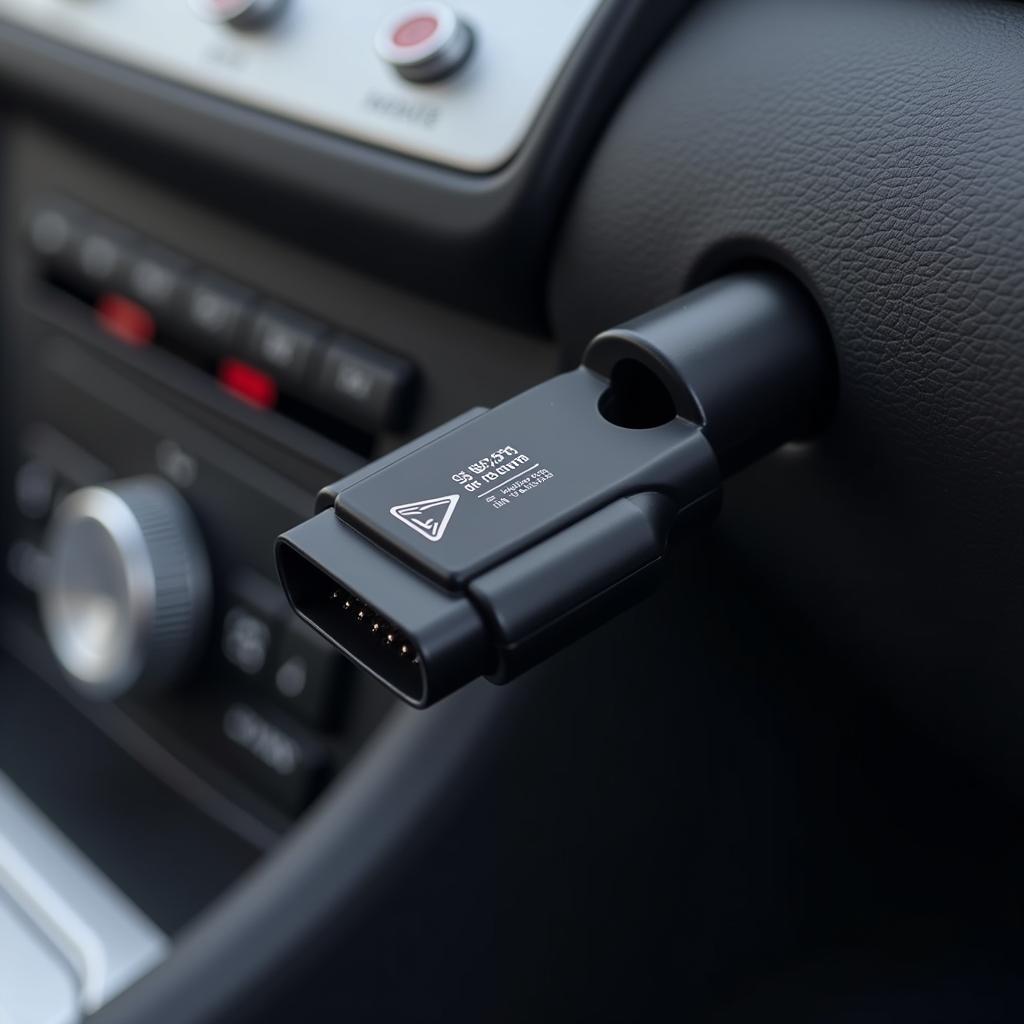The world of car diagnostics has seen a revolutionary shift with the advent of Obd Car Diagnostic Apps. These pocket-sized tools empower car owners to understand and often resolve car issues without needing a mechanic. But with a saturated market of options, choosing the right app for your needs can be overwhelming. This comprehensive guide delves into the world of OBD car diagnostic apps, providing you with the knowledge to make an informed decision.
 OBD Dongle Connected to a Car’s OBD Port
OBD Dongle Connected to a Car’s OBD Port
Understanding OBD and its Evolution
On-board diagnostics (OBD) systems are standardized systems incorporated in vehicles to monitor and report on engine and emissions performance. The system utilizes a standardized digital communication protocol, allowing a device to interface with the vehicle’s computer and retrieve diagnostic information.
Initially designed to monitor emissions control systems, OBD has evolved significantly. Modern OBD-II systems, mandatory in most vehicles manufactured after 1996, provide access to a wider range of data, including:
- Engine RPM
- Vehicle Speed
- Coolant Temperature
- Oxygen Sensor Data
- Fuel System Status
- And much more…
This treasure trove of information is precisely what OBD car diagnostic apps tap into.
How OBD Car Diagnostic Apps Work
OBD apps bridge the communication gap between your smartphone and your car. They require an OBD-II adapter, a small device that plugs into your car’s OBD port, usually located under the dashboard. This adapter establishes a Bluetooth or WiFi connection with your smartphone, allowing the chosen app to communicate with your car’s computer.
Once connected, the app translates the complex data from your car’s computer into user-friendly information, providing insights into:
- Reading and Clearing Diagnostic Trouble Codes (DTCs): When the check engine light illuminates, it usually indicates a DTC stored in your car’s computer. OBD apps can read these codes, providing a description of the potential problem. Many apps also allow you to clear these codes once the issue is resolved.
- Live Data Monitoring: Observe real-time data from various sensors, providing insights into your engine’s performance, fuel efficiency, and more.
- Performance Tracking: Some apps offer performance tracking features, allowing you to record acceleration times, track fuel economy over specific trips, and more.
Choosing the Right OBD Car Diagnostic App: Key Considerations
While the basic functionality of reading and clearing DTCs might be standard across most apps, several factors differentiate them:
- Vehicle Compatibility: Not all apps are compatible with all car makes and models. Check for compatibility with your specific vehicle before making a purchase.
- App Features: Apps offer a range of features beyond basic diagnostics. Some provide advanced features like live data graphing, emissions readiness checks, and even maintenance reminders.
- User Interface and Experience: Choose an app with an intuitive, user-friendly interface that presents information clearly and concisely.
- Cost and Subscription Models: OBD apps range from free to paid versions with monthly or annual subscriptions. Evaluate your needs and budget to determine the best option.
- User Reviews and Ratings: Always check user reviews and ratings on app stores to gauge the app’s reliability, accuracy, and overall user experience.
Beyond DIY: When to Consult a Professional
While OBD car diagnostic apps are powerful tools, they are not a substitute for professional diagnosis and repair. If your check engine light persists or you encounter complex car problems, it’s crucial to consult a qualified mechanic.
OBD apps can help you:
- Understand potential issues before visiting a mechanic.
- Monitor your car’s health and potentially catch problems early on.
- Save on unnecessary diagnostic fees if the issue is minor.
However, remember that OBD apps are diagnostic tools, not miracle workers. They can help you understand your car better, but ultimately, a professional mechanic possesses the expertise and experience to diagnose and repair complex issues effectively.
Conclusion
OBD car diagnostic apps have democratized car diagnostics, providing car owners with unprecedented access to their vehicles’ inner workings. By understanding how these apps work, their features, and their limitations, you can make informed decisions about your car’s health, potentially saving time and money.
However, remember that while these apps are powerful tools, they are most effective when used in conjunction with the expertise of a qualified mechanic. By striking a balance between self-reliance and professional guidance, you can ensure your car remains in optimal condition for miles to come.
Need help choosing the right OBD car diagnostic app for your needs? DiagFixPro offers expert reviews and comprehensive comparisons to help you make an informed decision.
Looking for more in-depth information on car diagnostics? Check out our articles:
We’re here to empower you with the knowledge you need to take control of your car’s health.

Leave a Reply